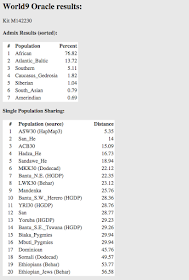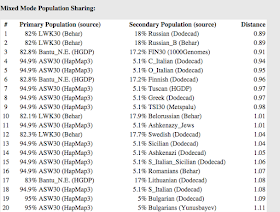Some of these reference populations, like most of us, contain genetic ancestry from "outside" populations and some of it may show up in our admixture for those very reasons. For example we may see a small amount of Siberian on our Dodecad World9 results and think it represents Native American when in actually it has something to do with our East African affinity. Huh?
Well the Spreadsheet may help us understand what Siberian would have to do with African by examining the population structures of the Oracles reference populations. In simple terms the Spreadsheet is like taking a person from one of the reference populations used to represent an ethnicity category on Gedmatch's Oracles program and running that person's kit number through the admixture calculators. Ultimately the Spreadsheet will help us make more practical inferences about why certain admixture is showing up our results.
In this blog I will show you how to use and interpret the Gedmatch Spreadsheet (in 4 steps):
(1) Assuming you've run your Gedmatch kit number through an admixture calculator (here I use Dodecad World9), simply click on the "Oracle" or "Oracle-4" button as shown here:
(2) You need to see your Oracle results (below) first before you run the Spreadsheet feature. This is because you'll need to know which of the Oracle reference populations you match on the Population Spreadsheet. For example my Dodecad World9 Oracle results reveal I have genetic similarity to the Bantu NE (Northeast African Bantu).


(3) Next return back to your Dodecad World9 results, and simply click on the "Spreadsheet" button as shown here:
(4) On the Population Spreadsheet for Dodecad World9 (below) you will get a list of Oracle reference populations' (vertical list) admixture contributions based upon the Gedmatch admixture calculator's "ethnicity" categories (horizontal list). Think Gedmatch calculator results for each reference population in the Oracle data set.
- Let's look at the first population "Bantu NE" on the vertical list (second to last). As you can see this Bantu NE sample contained African (92.89%) AS WELL AS small amounts of admixture from Southern (6.31%; Eastern Mediterranean), South Asian (0.40%), Siberian (0.20%) and East Asian (0.10%). The smaller amounts of admixture could represent such introgressions of populations (ie Southern) with ancient admixture (ie Siberian) such as could happen with Arab-Islamic contact with Madagascar (the Malagasy population is roughly 50% Bantu South African and 50% Island Southeast Asia), see Capredon et al. The majority of the Bantu NE affinity comes from Africa (multiple subregions), which makes sense if we consider the population migration and dispersal of the Bantu population, and potential gene-flow from those events.
- In application to my own results when I look at my Dodecad breakdown and see a strong affinity to Southern (Eastern Mediteranean), and corresponding Oracles program showing affinity to Bantu NE, I may hypothesize that the Southern percentage @ 5.51% may in part be the result of my affinity to Bantu NE shown in the Oracle program.This also means I have European, Siberian/Asian and African markers which look something like the Bantu NE's population structure and thus my higher genetic distance to them on the Oracle program. Further this could also mean I have ancestry from a Bantu population in East Africa, which also makes sense because I've known ancestry from Madagascar. So perhaps my Southern (East Mediterranean) and Siberian admixture percentages on Dodecad World 9 is because of my Bantu NE affinity instead of Native American as I priorly assumed. In context this may be compared to the Luhya-Kenya and Southwest Asian affinity showing on my National Genographic 2.0 admixture results, and thus lending more credence to my having ancestral origins with an East African Bantu population that may have been affected by Arab-Islamic introgression ... like my Malagasy relatives.
#End#



Can you please explain how the information on #3 relates to you, or how it would relate to me when I am looking at it? I see the information but I don't get how it relates to me. Thanks for such a clear example of how access the information
ReplyDeleteThe Oracles is a population fitting program, meaning your admixture percentages from any calculator are then compared to list of populations and your genetic distance or similarity is determined based on your calculator results. Do not take the populations as meaning your genetic make-up because it is just showing how close your DNA markers are to those of the reference population samples. You are probably not connected to any of the populations showing.
DeleteI have a question what does it mean when there are several 100s under American Indian for Example; 100 under all these: Peruvian, Cabecar, Aymara, Bolivian LaPaz, Chane, Guarani, Huichol, Inga, Kaqchikel, Karitiana, MIxe, Mixtec, Piapoco, Pima, Quechu RuizLinares, Suri, Ticuna, Wayuu,and Wichi? and it was also 99.98 Zapotec and 97.76 Mayan. In my total admixture I am 17 percent American Indian.
DeleteMy 99yr old aunt had similar results from Oracle spreadsheet as those from this "Unknown" persons post Aug. 26,2016
DeleteTL Dixon. Thank you for explaining the spreadsheet feature. I actually think I understand it much better. I will definitely play around with it the next time I'm on Gedmatch.
ReplyDeleteYou're welcomed Veggia Mahn. Thanks and let me know if you have questions.
DeleteMy wife is strongly Lebanese. We both did Ancestry DNA testing and uploaded our results to Gedmatch. When I run a spreadsheet for myself and then run my wife's test on the same admixture comparison, the spreadsheets are identical which is impossible. What am I doing wrong? My kit # is A019721 and hers is A079771.
ReplyDeleteL
Hi Lamar,
DeleteThe spreadsheet is not meant to complement your Gedmatch calculator results or percentages. Instead it focuses on the REFERENCE POPULATIONS and how each reference population might show up on the calculator you are using. This is why the populations on the spreadsheet did not change with you and your wife. Essentially you are seeing how each ORACLES reference population breaks down if you were to run it through a Gedmatch calculator. This may tell you more about the structure of the reference population.
Thanks so much. This is fascinating and you are brilliant.
DeleteLamar
My wife and I did DNA tests through Ancestry. We uploaded our results to Gedmatch. Her test # is A079771 and mine is A019721. She is about 25% Lebanese. I am not. When I run the same admixture test on both of us and then the Gedmatch spreadsheet. The tables are exactly the same for both of us. This can't be right. What am I doing wrong?
ReplyDeleteThanks,
Lamar
So, under each ethnicity the spreadsheet breaks down the percentages according to that specific area population? Example under West African if it state yourba 100. Is it safe to say that that's a good chance I have Yourba ancestry?
ReplyDeleteNo. You are not related to any of the reference populations showing up for you. What it means is the Yoruba sample used for Oracles did not have any non-African admixture. The only thing you can deduce from this is the likelihood you have DNA from a West African population but it may not be Yoruba or Igbo.
DeleteHello😊 Wonderful post so just to clarify the closer to 100 on a spreadsheet indicates some common DNA with the population subject?
ReplyDeleteThanks. You do not share any DNA with the reference populations, which would be very rare. However your DNA may be more similar to some reference populations than others. In terms of Genetic Distance the closer to 0 (Zero) you are to a reference population the more you share in similarity, but not kinship.
ReplyDeleteThanks. You do not share any DNA with the reference populations, which would be very rare. However your DNA may be more similar to some reference populations than others. In terms of Genetic Distance the closer to 0 (Zero) you are to a reference population the more you share in similarity, but not kinship.
ReplyDeleteCan someone explain something to me? M153456 is my kit number and I ran my numbers through the population spreadsheet, and came across a number that said "100" does that mean I'm 100% something? I saw it under "Karitiana" listed under Amerindian. Please help me figure this out. Thanks!
ReplyDeleteHello, I am having trouble understanding the spreadsheet and oracles. I noticed that you said that you can not be related to the reference populations. However, my father was mixed with Dominican and African american and in my single population sharing it says (Dominican and African american) however the distance is very far 22 for Dominican and 38 for African american. Do you know why this could be? Does it mean that I do not share this DNA?
ReplyDeleteso if my numbers down the American Indian side are high does that mean i have that group of Native American in my dna and the higher the number the better?
ReplyDeleteTo determine my admixture, which should I use and why? Dodecad, Europe, Harappa, gedrosia? How do I know which one of those I choose? Or do I just assume that the company I tested with knows my ethnicity? I'm not a geneticist so this is very confusing. So many of the tools that GEDMATCH uses seems to be for fun for many of us. I show .54 Amerindian on ancestry, but .78 on another. I'm told that's just noise. So as I suspect others do, they start to search out if that noise really means anything. I get frustrated because many think I'm trying to be in a tribe. I'm not. I'm just as interested in the Iberian and Jewish cousins that are showing up.
ReplyDeleteSearch Sephardic gedmatch. It's confusing. I'm 3% not Jewish, it's Belarus/Lithuanian area (according to my heritage) but if you put me most of the admixture in gedmatch, it'll show everything. Almost, everything, I got Cherokee and another tribe.. I'm mostly Ashkenazi , 9% Mizrahi/Sephardic (again, only according to my heritage. Ged match also matched me using the same tool, different reference as half Basque. Half Samaritan (which is half of ancient Israel, they're Jews, but centuries ago they were one tribe fought (siblings & they broke off , they're as inbred as Saudi Arabia, Pakistan, etc.... AKA very. But they're good for genetics, because there's not movement. Still, don't use those. Look up gedmatch and Sephardic (or Tunisian Jewish, etc. ) also take your raw data to myheritage, family tree dna, dna.land etc.
DeleteHi.. I'm very confused...apprehended at birth met my birth mom briefly before she passed... she took her secret to the grave... my father's name n ethnicity... I did a ancestry.com DNA test.. which showed Hungary Romania Poland Austria on my dads side...there was a rumour n by my features n skin colours my dad was part gypsy Roma... my kit number is A711597 on gedmatch.. can anyone help?!
ReplyDelete